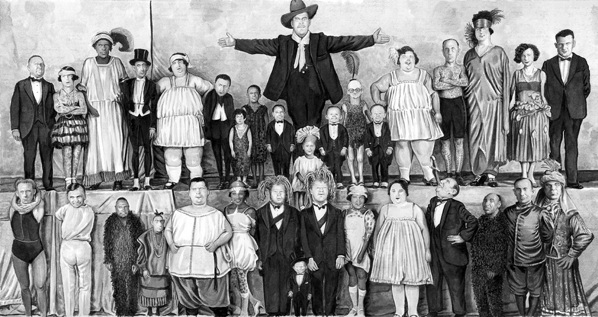The Latest from Boing Boing |  |
- "Joy of Easy Listening" documentary from the BBC Four
- Dropbox accounts left open for 4 hours due to programming bug
- The world is full of fake sounds
- The unbearable sadness of winter tomatoes
- Glasses with 720p HD video camera
- How hangovers work
- Selective attention: More than just missing the man in the gorilla suit
- National Institutes of Health 1.0
- Homebrew 8-bit computer
- Tracking hurricanes and cyclones online: a dozen of the web's best sites
- New rankings of world's fastest supercomputers released: Japan, China, US take top three spots
- Most common iPhone unlock codes
- Institute for the Future seeks Web developer
- Julian Assange not being surveilled by cameras after all, admits "bail mansion" host
- Journalist and family shot dead in Mexico
- Revolator: bonkers plan for a vertical shopping mall navigated by a glassed-in Ferris wheel
- Mean things authors say about each other
- Drew Friedman's Sideshow Freaks art print
- Gweek 008: 250 Indie Games You Must Play
- Holga lenses now on everything
| "Joy of Easy Listening" documentary from the BBC Four Posted: 20 Jun 2011 07:13 PM PDT The new BBC Four documentary "The Joy of Easy Listening" has been uploaded to YouTube. From the BBC Four: The film looks at easy listening's architects and practitioners, its dangers and delights, and the mark it has left on modern life."Joy of Easy Listening" (YouTube) |
| Dropbox accounts left open for 4 hours due to programming bug Posted: 20 Jun 2011 07:05 PM PDT Wired News: "Dropbox, one of the most popular ways to share and sync files online, says the accounts became unlocked at 1:54pm Pacific time Sunday when a programming change introduced a bug." Four hours later, the hole was closed. Security researcher Christopher Soghoian was the first to notice the (um, gaping) security hole. |
| The world is full of fake sounds Posted: 20 Jun 2011 01:52 PM PDT The ATM machine doesn't actually go, "whhrrrrrrrrr." The satisfying "clunk" of a car door wouldn't happen without careful engineering. Humans Invent explains the stories behind these, and three other everyday sounds that aren't as real as we've been led to believe. (Via Dylan Sharpe) |
| The unbearable sadness of winter tomatoes Posted: 20 Jun 2011 01:47 PM PDT  Journalist Barry Estabrook has won two James Beard Awards for his writing about food. His newest book, called Tomatoland, is about ... er ... the tomato. More importantly, it's about what it takes to grow food that can meet full-year, everywhere, low-cost demand and how the changes we've made to agriculture have both helped us and hurt us. You can read an excerpt, about growing tomatoes in Florida, at On Earth magazine. It's a prime example of the kind of trade-offs Estabrook is talking about. To get a glistening red tomato in the depths of winter, you have to grow the fruit in a place and using techniques that pretty much ensure the tomatoes you do get won't taste nearly as good as you want them to.
Image: Tomatoes at Pike Place, a Creative Commons Attribution No-Derivative-Works (2.0) image from maplessinseattle's photostream |
| Glasses with 720p HD video camera Posted: 20 Jun 2011 03:37 AM PDT Eyez is a massively oversubscribed Kickstarter project to develop and ship a 200g pair of glasses with a hidden 720p video-camera, mic, and 8GB of memory. The glasses are styled to resemble Wayfarers, and can record locally or stream via Bluetooth to a mobile phone. Kickstarter supporters can pre-order for $150; they'll retail for $200 when (and if) they ship. Our engineering team at ZionEyez is currently developing Eyez, the latest innovation in personal video recording technology. Eyez embeds a 720p HD video camera within a pair of eyeglasses designed to record live video data. The recorded data can be stored on the 8GB of flash memory within the Eyez glasses, transferred via Bluetooth or Micro USB to a computer, or wirelessly transferred to most iPhone or Android devices. After a one-time download of the "Eyez" smartphone and tablet app, users can wirelessly broadcast the video in real time to their preferred social networking website.Eyez by ZionEyez HD Video Recording Glasses for Facebook (via O'Reilly Radar) |
| Posted: 20 Jun 2011 01:23 PM PDT The BBC has made an excellent short video explaining the science behind hangovers for their upcoming program "James May's Things You Need To Know ... About the Human Body." It's great stuff, and very much worth watching. Sadly, they did not include an embed option. To watch the clip, you'll have to jump over to their website. |
| Selective attention: More than just missing the man in the gorilla suit Posted: 20 Jun 2011 01:01 PM PDT In a study of selective attention, 2/3 of the subjects completely failed to notice a fight in the park because they were too busy paying attention to how many times the jogger in front of them touched his hat. (Via Eric Sorenson) |
| National Institutes of Health 1.0 Posted: 20 Jun 2011 12:53 PM PDT  This is what the American National Institutes of Health looked like back when it consisted of one office on Staten Island, manned by a single 20-something researcher. It's almost a little insane to think about now, but when it first opened in 1887, the " Laboratory of Hygiene" (as it was then called) was entirely staffed by one man, 27-year-old Joseph James Kinyoun.
This bit of fascinating history brought to you by The Scientist magazine. |
| Posted: 20 Jun 2011 03:49 AM PDT A recent high-school grad named Jack Eisenmann homebrewed his own 8-bit computer, wiring up a custom CPU and GPU, writing an OS and hex editor, and producing a suite of demo apps including some fun little games: Jack Eisenmann, a programmer who just graduated high school, has built his own 8-bit homebrew computer completely from scratch using an old keyboard, a television, and a ton of TTL logic chips. No, he didn't buy some computer parts and snap them together; he blueprinted every wire and connection and then built it, wire by wire. After he finished construction, he had to teach it how to communicate, so he created his own operating system and wrote some games for it. That's dedication.Duo Adept: An 8-bit computer designed and built by Jack Eisenmann, a high school student. High school grad builds 8-bit computer from scratch, complete with custom OS and Pong (Yahoo News) (via Engadget) |
| Tracking hurricanes and cyclones online: a dozen of the web's best sites Posted: 20 Jun 2011 12:56 PM PDT  The maritime professionals website gCaptain has an item up today that ranks the best hurricane and cyclone tracking websites for the 2011 season. Here's a reminder of why you might be interested, even if you're not planning to be out boating on the ocean yourself: hurricane season is upon us, and this year's edition looks to be busy: The consensus of the various 2011 hurricane outlooks suggest the Atlantic 2011 season will see between 13 and 17 named storms, 7-9 hurricanes and 4-5 major hurricanes. The average season has about 10 named storms, 6 hurricanes and 2 intense hurricanes. And here's the list. Today, tropical storm Beatriz is the one to watch, and is expected to hit Mexico with some force within the next 24 hours. |
| New rankings of world's fastest supercomputers released: Japan, China, US take top three spots Posted: 20 Jun 2011 12:21 PM PDT  (Image: the K Computer, courtesy RIKEN) The 37th edition of the "TOP500 List of the world's top supercomputers" was released today at the 2011 International Supercomputing Conference in Hamburg. At first place, a Japanese supercomputer capable of performing more than 8 quadrillion calculations per second (petaflop/s): the K Computer, developed in partnership with Fujitsu at the RIKEN Advanced Institute for Computational Science (AICS) in Kobe. The ranking of all systems is based on how fast they run Linpack, a benchmark application developed to solve a dense system of linear equations. For the first time, all of the top 10 systems achieved petaflop/s performance - and those are also the only petaflop/s systems on the list. The U.S. is tops in petaflop/s with five systems performing at that level; Japan and China have two each, and France has one.More: Top500.org. NASA's related press release about the Pleiades supercomputer at Ames is here. |
| Most common iPhone unlock codes Posted: 20 Jun 2011 04:13 AM PDT  This chart shows the 10 most common iPhone numeric lock-codes, as anonymously gathered by the Big Brother Security Camera app (now removed from the App Store). They represent 15% of all 204,508 passcodes sampled. I wonder how strongly they correlate with other numeric PINs, such as ATM/Chip-and-PIN codes. Interestingly, 1990-2000 are all in the top 50, and 1980-1989 are all in the top 100. I would interpret this occurrence as a subset of users that set their passcodes to the year of their birth or graduation.Most Common iPhone Passcodes (via Smagdali) |
| Institute for the Future seeks Web developer Posted: 20 Jun 2011 12:15 PM PDT Institute for the Future, the Palo Alto non-profit where I'm a research director, is seeking a Web developer to do some very interesting work around online gaming and our Foresight Engine, IFTF's Web platform to collect forecasts from thousands of participants. This gig is a part-time consulting position and applicants should be in the SF Bay Area. Follow the link below to apply. (I'm not personally involved in the search.) IFTF Web Developer wanted |
| Julian Assange not being surveilled by cameras after all, admits "bail mansion" host Posted: 20 Jun 2011 11:36 AM PDT Vaughan Smith, who is hosting Wikileaks founder Julian Assange at his "Bail Mansion" in England, recently claimed that intelligent surveillance cameras had been installed nearby. Those claims were repeated in various news outlets. But Mr. Smith says he now understood the "cameras" were just radar-operated speed signs. More from the BBC: Claims about the "cameras" near the house's three entrances were made in a video produced by supporters of Mr Assange, criticising his bail conditions. In the video, Mr Smith, who owns the Frontline Club in Paddington, West London, said: "I'm not an expert on cameras but I believe these take number plates and record number plates." He went on say that the "cameras" had been installed at some time in the past three months.Here's the video.
|
| Journalist and family shot dead in Mexico Posted: 20 Jun 2011 11:38 AM PDT  Journalist Miguel Angel Lopez Velasco, his wife, and their 21-year-old son were shot to death inside their home in Veracruz, Mexico today. Snip from AP report: Lopez Velasco wrote a column about politics and crime and was editorial director for the daily newspaper Notiver. His son had been working as a photographer for the same newspaper.Another reporter was found dead in Veracruz just earlier this month. Mexico is the most dangerous country in the Americas for journalists, according to various press freedom groups: More than 60 have been murdered there since 2000, according to Mexico's National Human Rights Commission (Comisión Nacional de los Derechos Humanos, or "CNDH"). More than 36,000 people have died in "narcoviolence" since Mexico's president Felipe Calderon initiated a military-led crackdown on drug cartels in 2006. More coverage: AFP, Notimex, El Universal, BBC, |
| Revolator: bonkers plan for a vertical shopping mall navigated by a glassed-in Ferris wheel Posted: 20 Jun 2011 04:15 AM PDT  The Jun, 1977 issue of Popular Science featured this insane plan for a vertical shopping mall that used a kind of Ferris wheel to rotate customers past the windows of shops. Anyone know if this thing ever got built? Cabs in this people-mover will whisk up and down on a continuous belt--something like a Ferris wheel. The Revolator is planned for a multilevel shopping center that's being built in Morristown, N.J. Each cab will hold 150 shoppers, so a six-unit system could transport 40,000 an hour--far more than elevators or escalators. Cabs will move in unison every 60 seconds, stopping at each floor. The glass-enclosed system gives shoppers a view of all stores as they pass each floor. "Visibility and store frontage are of prime consideration in vertical centers," says architect Lathrop Douglas whose firm conceived the Revolator.For faster shopping: a Revolator (Jun, 1977) |
| Mean things authors say about each other Posted: 20 Jun 2011 10:32 AM PDT Flavorwire has assembled a collection of the 30 meanest things well-regarded writers have said about each other over the years. Some of my favorites are collected below: 21. Lord Byron on John Keats (1820)The 30 Harshest Author-on-Author Insults In History (via RobertHoge) |
| Drew Friedman's Sideshow Freaks art print Posted: 20 Jun 2011 08:08 AM PDT  The inimitable portrait artist Drew Friedman, whose Sideshow Freaks paintings and book we featured back in January, is now offering this amazing "family portrait" in a very limited edition fine art print. The painting is based on a 1934 photo of Ringling Bros. and Barnum & Bailey sideshow performers. And soon, these characters will be presiding over my living room. Sideshow Freaks
|
| Gweek 008: 250 Indie Games You Must Play Posted: 17 Jun 2011 05:42 PM PDT  This is an all-gaming episode of Gweek! Rob, Joel (of Kotaku), and I chatted with Mike Rose, who is a freelance games journalist, an editor at Indie Games, and the author of 250 Indie Games You Must Play. Here's what we talked about: • A retro platformer called, VVVVVV (pronounced "vee"). • The soundtrack to VVVVVV, called PPPPPP. • Terraria Online, a 2D multiplayer Minecraft. • Project Zomboid, a zombie survival RPG. • Nintendo's head-scratching Wii U. • Sony's new portable game player, the PS Vita • Mobile Minecraft on Sony Ericsson's Xperia Play • A trippy game for Xbox and Playstation that Joel declares to be "very Boing Boing," Child of Eden • Rob's new exclusive flash game for Boing Boing: 9x9RPG • Another game from Boing Boing Gadgets, Low-Altitude Attack Zeppelin • The NBC TV series, Community Download Gweek 008 as an MP3 | Subscribe to Gweek via iTunes | Subscribe via RSS | Download single episodes of Gweek as MP3s |
| Holga lenses now on everything Posted: 20 Jun 2011 06:54 AM PDT Remember the inexpensive plastic Holga lenses for Nikon and Canon mounts? Now they're available for all the other DLSR lens formats, too. [Holga Direct] |
| You are subscribed to email updates from Boing Boing To stop receiving these emails, you may unsubscribe now. | Email delivery powered by Google |
| Google Inc., 20 West Kinzie, Chicago IL USA 60610 | |


 Required skills
Required skills
No comments:
Post a Comment